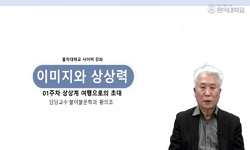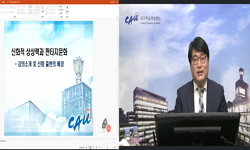The purpose of this research is to examine aspect of acceptances of the folktale shown in the historical novel, <The dragonfloating under the earth(천하에 뜨는 용)>. <The dragon floating under the earth>was made into novel upon the v...
http://chineseinput.net/에서 pinyin(병음)방식으로 중국어를 변환할 수 있습니다.
변환된 중국어를 복사하여 사용하시면 됩니다.
- 中文 을 입력하시려면 zhongwen을 입력하시고 space를누르시면됩니다.
- 北京 을 입력하시려면 beijing을 입력하시고 space를 누르시면 됩니다.

『천하에 뜨는 용』에 나타난 설화의 수용양상 = Eexamine Aspect of Acceptances of the Folktale Shown in the <The Dragonfloating under the Earth>
한글로보기https://www.riss.kr/link?id=A99601388
- 저자
- 발행기관
- 학술지명
- 권호사항
-
발행연도
2013
-
작성언어
-
- 주제어
-
KDC
810
-
등재정보
KCI등재
-
자료형태
학술저널
- 발행기관 URL
-
수록면
125-147(23쪽)
-
KCI 피인용횟수
0
- 제공처
-
0
상세조회 -
0
다운로드
부가정보
다국어 초록 (Multilingual Abstract)
There is so liitle literature records about Yeong-gyu Daesa that one cannot know his detailed account. Yeong-gyu Daes a was one of the Parks who had Giheodang(기허당) as his buddist name. He was also the first pupil of Seosan Daeso from Chengnyeon-am(청련암) in Gapsa(갑사). Yeong-gyu Daes a had gathered the cavalry of civil before anybody else. He and Joheon, his company, had recaptured the Cheongju fortress but he couldn't help but take his last breath with the lose from the Geuman battle.
<The dragon floating under the earth>is a conte that consists of 10 chapters. This novel is significant because it is a piece of work about Yeong-gyu Daes a with the background of Japnese Invasion, it takes insertions of many tales and it gives a meaning to Yeong-gyu Daesa's efforts for his fatherland. The novel, <The dragon floating under the earth>, accepts several kinds of tale to emphasize on his heroism. Some of the acceptances is directly relevant to Yeong-gyu Daesa, but some of them are absoultely not. If one takes a look at the novel in the points of the acceptance of tales by chapters, it can be classified in to three. First, a modified acceptance of stories in tales and cases. Second, a realistic modification and an acceptance with imaginations. Third, an acceptance of imaginary stories of tales.
The purpose of this research is to examine aspect of acceptances of the folktale shown in the historical novel, <The dragonfloating under the earth(천하에 뜨는 용)>. <The dragon floating under the earth>was made into novel upon the various tales about Yeong-gyu Daesa(영규대사), the commander o farmy of civil, who had mounted troops In Gaps a when Japanese Invasion of Koreain 1592 had broken out.
There is so liitle literature records about Yeong-gyu Daesa that one cannot know his detailed account. Yeong-gyu Daes a was one of the Parks who had Giheodang(기허당) as his buddist name. He was also the first pupil of Seosan Daeso from Chengnyeon-am(청련암) in Gapsa(갑사). Yeong-gyu Daes a had gathered the cavalry of civil before anybody else. He and Joheon, his company, had recaptured the Cheongju fortress but he couldn't help but take his last breath with the lose from the Geuman battle.
<The dragon floating under the earth>is a conte that consists of 10 chapters. This novel is significant because it is a piece of work about Yeong-gyu Daes a with the background of Japnese Invasion, it takes insertions of many tales and it gives a meaning to Yeong-gyu Daesa's efforts for his fatherland. The novel, <The dragon floating under the earth>, accepts several kinds of tale to emphasize on his heroism. Some of the acceptances is directly relevant to Yeong-gyu Daesa, but some of them are absoultely not. If one takes a look at the novel in the points of the acceptance of tales by chapters, it can be classified in to three. First, a modified acceptance of stories in tales and cases. Second, a realistic modification and an acceptance with imaginations. Third, an acceptance of imaginary stories of tales.
목차 (Table of Contents)
- 1. 서론
- 2. 영규대사의 삶과 소설의 구성
- 3. 『천하에 뜨는 용』에 나타난 설화의 수용 양상
- 4. 결론
- 참고문헌
- 1. 서론
- 2. 영규대사의 삶과 소설의 구성
- 3. 『천하에 뜨는 용』에 나타난 설화의 수용 양상
- 4. 결론
- 참고문헌
- Abstract
참고문헌 (Reference)
1 "행동명장전(名將傳)"
2 정정섭, "천하에 뜨는 용" 도서출판 다래 2002
3 한국정신문화연구원 한국학대학원, "조사보고서 2집"
4 "조두록(俎豆錄)"
5 "제조번방지"
6 이형석, "임진전란사" 임진전란사간행위원회 469-470, 1974
7 김승호, "임진시 승장의 성화 전승 양상-영규대사를 중심으로" 동악어문학회 36 : 351-369, 2000
8 정인보, "의승장기허당대사기적비명(義僧將騎虛堂大師紀蹟碑銘)"
9 강현모, "영규대사 설화의 연구 - 설화의 지역적 전승양상과 서사문법을 중심으로 -" 한민족문화학회 (31) : 283-312, 2009
10 신동흔, "역사인물담의 현실대응방식 연구 : 계룡산 인근지역 현지조사 자료를 중심으로" 서울大學校 大學院 1993
1 "행동명장전(名將傳)"
2 정정섭, "천하에 뜨는 용" 도서출판 다래 2002
3 한국정신문화연구원 한국학대학원, "조사보고서 2집"
4 "조두록(俎豆錄)"
5 "제조번방지"
6 이형석, "임진전란사" 임진전란사간행위원회 469-470, 1974
7 김승호, "임진시 승장의 성화 전승 양상-영규대사를 중심으로" 동악어문학회 36 : 351-369, 2000
8 정인보, "의승장기허당대사기적비명(義僧將騎虛堂大師紀蹟碑銘)"
9 강현모, "영규대사 설화의 연구 - 설화의 지역적 전승양상과 서사문법을 중심으로 -" 한민족문화학회 (31) : 283-312, 2009
10 신동흔, "역사인물담의 현실대응방식 연구 : 계룡산 인근지역 현지조사 자료를 중심으로" 서울大學校 大學院 1993
11 숭전대, "숭전어문학 4집"
12 조인형, "순의비명(殉義碑銘)"
13 "선조실록(宣祖實錄)"
14 "선조수정실록"
15 김균태, "새내(금강본류1,2,금내,버드내1,2)유역의 구비설화"
16 윤선각, "문소만록(聞韶漫錄)"
17 강현모, "대왜 항전 설화에 나타난 교육적 의미-새내 지역과 금산군 서부 지역 전설을 중심으로-" 한민족문화학회 (17) : 185-209, 2005
18 "대동기문(大東奇聞)"
19 "난중잡록"
20 허경진, "금산의 임진왜란 이야기" 금산군문화공보관광과 2004
21 강현모, "공주논산지역 영규대사 현지조사자료"
22 "공주 전통과 맥"
23 강현모, "<성재 전설>의 전승 배경과 등장인물의 특성" 비교민속학회 (32) : 371-401, 2006
동일학술지(권/호) 다른 논문
-
『한국언어문학 에 게재된』 고전시가 연구의 현황과 전망
- 한국언어문학회
- 김명준(Kim, Myung-joon)
- 2013
- KCI등재
-
- 한국언어문학회
- 오세정
- 2013
- KCI등재
-
- 한국언어문학회
- 이상구
- 2013
- KCI등재
-
- 한국언어문학회
- 박영환(Park, Young-hwan)
- 2013
- KCI등재
분석정보
인용정보 인용지수 설명보기
학술지 이력
| 연월일 | 이력구분 | 이력상세 | 등재구분 |
|---|---|---|---|
| 2028 | 평가예정 | 재인증평가 신청대상 (재인증) | |
| 2022-01-01 | 평가 | 등재학술지 유지 (재인증) |  |
| 2019-01-01 | 평가 | 등재학술지 유지 (계속평가) |  |
| 2016-01-01 | 평가 | 등재학술지 선정 (계속평가) |  |
| 2015-12-01 | 평가 | 등재후보로 하락 (기타) |  |
| 2011-01-01 | 평가 | 등재학술지 유지 (등재유지) |  |
| 2009-01-01 | 평가 | 등재학술지 유지 (등재유지) |  |
| 2007-01-01 | 평가 | 등재학술지 유지 (등재유지) |  |
| 2005-01-01 | 평가 | 등재학술지 유지 (등재유지) |  |
| 2002-01-01 | 평가 | 등재학술지 선정 (등재후보2차) |  |
| 1999-07-01 | 평가 | 등재후보학술지 선정 (신규평가) |  |
학술지 인용정보
| 기준연도 | WOS-KCI 통합IF(2년) | KCIF(2년) | KCIF(3년) |
|---|---|---|---|
| 2016 | 0.31 | 0.31 | 0.28 |
| KCIF(4년) | KCIF(5년) | 중심성지수(3년) | 즉시성지수 |
| 0.3 | 0.32 | 0.556 | 0.11 |




 스콜라
스콜라






